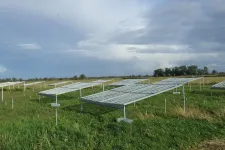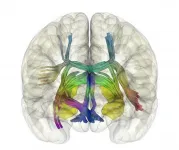Less precipitation means less plant diversity
Climate change might lead to changes in plant diversity, especially in the world's drylands
2021-05-03
(Press-News.org) Water is a scarce resource in many of the Earth's ecosystems. This scarcity is likely to increase in the course of climate change. This, in turn, might lead to a considerable decline in plant diversity. Using experimental data from all over the world, scientists from the Helmholtz Centre for Environmental Research (UFZ), the German Centre for Integrative Biodiversity Research (iDiv), and the Martin Luther University of Halle-Wittenberg (MLU) have demonstrated for the first time that plant biodiversity in drylands is particularly sensitive to changes in precipitation. In an article published in Nature Communications, the team warns that this can also have consequences for the people living in the affected regions.
How will climate change affect the Earth's ecosystems? How will biodiversity in different regions change? Such important questions about the future are difficult to answer. In order to do so, it is important to know how the individual species and their communities will react to changing precipitation conditions, for example. But despite numerous scientific experiments worldwide, we do not have synthetic, global answers to these questions. For example, experiments differ greatly in their methodology, such as whether they add small or large amounts of water. "These studies use different methods and are located in different regions of the world", says first author Dr. Lotte Korell, a biologist at the UFZ. "And these studies yield contradictory results in many cases". Together with her colleagues, she has therefore set out to derive a general understanding from the data collected worldwide. The focus was on how an increase or decrease in precipitation affects the plant diversity of terrestrial ecosystems.
In their search, she and her team found 23 usable publications, which presented results from 72 field experiments. With this data, they calculated various statistical variables that provided information about the biodiversity at the individual sites and related them to the increasing or decreasing amounts of rainfall.
"However, in such experiments, biodiversity depends on many factors", says Prof. Dr. Tiffany Knight, last author of the study and ecologist at the UFZ, iDiv, and MLU. For example, the size of the experiment plays an important role. If you focus on only a single experimental plot, then you might see dramatic effects of treatments on biodiversity, as plots with less water have fewer plant individuals growing there, and thus fewer species. However, at least one individual of every species might be found in at the larger scale, and thus a lower effect of the treatment on biodiversity. Indeed, the researchers found that increasing dryness has a greater effect when it is considered at small compared to larger spatial scales. "Thus, in order to draw the right conclusions from the data, you have to take into account both the local climate conditions and the spatial scale of the experiments", says Knight.
In this way, the researchers have identified a clear trend. In the drylands of the world, changes in precipitation levels have a much greater effect than in wetter regions.
Dry ecosystems currently occupy about 40% of the Earth's land surface. It is not easy to predict what awaits these areas against the backdrop of climate change. Although climate models do predict increasing rainfall in some dry regions, the water shortage is likely to worsen in most of them.
According to the study, plant diversity is expected to increase where it becomes wetter. This is probably because the seeds of the species found there may have a better chance of germinating and becoming established.
However, in light of the projected expansion of drylands, this effect is likely to benefit only relatively few regions. According to the authors, this would lead to a noticeable decline in plant diversity. "Although the plants there have adapted to the challenges of their habitats over long periods of time", says Korell, "at some point, even the most resilient survivor reaches its limits". And with every species that dries up and can no longer germinate, biodiversity is reduced.
This could be bad news not only for the ecosystems but also for the inhabitants of the dry regions. After all, they account for about one third of the world's population. Many of these people struggle to make a living from the land under the most difficult conditions. If biodiversity declines along with the rainfall, this is likely to become an even greater challenge. For Korell and her colleagues, this is another pressing argument for slowing climate change. "It is also important to protect the drylands particularly well", says the researcher. The more these sensitive ecosystems are put under pressure from overgrazing and other stress factors, the more climate change is likely to affect plant diversity.
INFORMATION:
[Attachments] See images for this press release:

ELSE PRESS RELEASES FROM THIS DATE:
2021-05-03
The terms "co-creation" and "co-production", which denote the possibility for laypeople to participate in decision-making processes that affect their lives, have been gaining popularity. A new IIASA-led study explored options for empowering citizens as a driver for moving from awareness about the need to transform energy systems to action and participation.
The European Union's climate and energy policies for 2020-2030 require decarbonization of the energy sector. To this end, EU member countries are working on a number of key goals including greater energy efficiency, greater use of renewable energy, and increased energy security across the EU. The successful ...
2021-05-03
In recent decades, Spain has undergone rapid social changes in terms of gender equality, despite, as a result of the Franco dictatorship, starting from a more backward position than most European countries. This process is hampered by the economic downturn that began in 2008, underlining the importance of the economic context in the development of gender inequality levels. Little attention has been paid in academia to how this gender revolution is associated with factors related to individual wellbeing.
A study by Jordi Gumà, a researcher at the Department of Political and ...
2021-05-03
The human world is, increasingly, an urban one -- and that means elevators. Hong Kong, the hometown of physicist Zhijie Feng (Boston University),* adds new elevators at the rate of roughly 1500 every year...making vertical transport an alluring topic for quantitative research.
"Just in the main building of my undergraduate university, Hong Kong University of Science and Technology," Feng reflects, "there are 37 elevators, all numbered so we can use them to indicate the location of hundreds of classrooms. There is always a line outside each elevator lobby, and if they are shut down, we have to hike for 30 minutes."
Feng and Santa Fe Institute Professor ...
2021-05-03
Myotonic dystrophy is a hereditary degenerative neuromuscular disease that occurs mainly in adults, affecting about 50,000 people only in Spain. Symptoms range from difficulty walking and myotonia (great difficulty in relaxing the contracted muscles) to severe neurological problems, leading to progressive disability that unfortunately puts many of those affected in a wheelchair. This disease is very heterogeneous among patients (age of onset, progression, hereditary transmission, affected muscles), which makes the development of generic treatments especially complex.
Currently, drugs against myotonic ...
2021-05-03
LAWRENCE -- Like much of society, college athletics were thrown into disarray by the COVID-19 pandemic. While student athletes were suddenly prevented from competing, training or seeing as much of their teammates and coaches, those who perceived they were part of a positive sporting environment also coped better during the early days of the crisis, a new study from the University of Kansas has found.
KU researchers have long studied a caring, task-involved sporting climate, in which young athletes receive support and recognition for their efforts, while mistakes are treated as learning opportunities. But the pandemic provided a unique opportunity to see whether the approach helped collegiate athletes cope with the unique stresses and challenges that came with the disruption ...
2021-05-03
Social media may make it easier for people to engage online, but I does not provide certain benefits of real-life human interactions, says a Michigan State University researcher.
"Problematic social media use has been associated with depression, anxiety and social isolation, and having a good social support system helps insulate people from negative mental health," said Dar Meshi, an assistant professor in the Department of Advertising and Public Relations at MSU. "We wanted to compare the differences between real-life support and support provided over social media to see if the support provided over social media could have beneficial effects."
The research was published online April 29 in the journal Addictive Behaviors.
While ...
2021-05-03
Living materials, which are made by housing biological cells within a non-living matrix, have gained popularity in recent years as scientists recognize that often the most robust materials are those that mimic nature.
For the first time, an international team of researchers from the University of Rochester and Delft University of Technology in the Netherlands used 3D printers and a novel bioprinting technique to print algae into living, photosynthetic materials that are tough and resilient. The material has a variety of applications in the energy, medical, and fashion sectors. The research is published in ...
2021-05-03
Nearly 10,000 acres of lush seagrass vanished from Florida Bay between 1987 and 1991, leading to massive ecological changes in the region near the Florida Keys. Abundance of the seagrass, Thalassia testudinum, more commonly known as turtlegrass, a foundation species of the Florida Bay ecosystem, decreased extensively during what is considered to be one of the largest declines in seagrass cover in recent history.
Researchers from the University of South Florida, the Florida Fish and Wildlife Conservation Commission (FWC) and the University of North Carolina Wilmington documented the response of seagrasses after the die-off. ...
2021-05-03
31 percent of pet dogs and 40 percent of pet cats tested positive to COVID-19 after their owners' own diagnoses, though under half displayed symptoms, in small Brazilian study.
INFORMATION:
Publicly available article: https://journals.plos.org/plosone/article?id=10.1371/journal.pone.0250853
Article Title: Investigation of SARS-CoV-2 infection in dogs and cats of humans diagnosed with COVID-19 in Rio de Janeiro, Brazil
Funding: MMS: This study was supported by CGLab/MoH (General Laboratories Coordination of Brazilian Ministry of Health), CVSLR/FIOCRUZ (Coordination of Health Surveillance and Reference Laboratories ...
2021-05-03
Thanks to the so-called deep learning, a subset of artificial intelligence (AI) algorithms inspired by the brain, machines can match human performance in perception and language recognition and even outperform humans in certain tasks. But do these synthetic biologically inspired systems learn in the same way that we do?
According to a new article by first author Dr. Diogo Santos-Pata from the Synthetic Perceptive, Emotive and Cognitive Systems lab (SPECS) at IBEC led by ICREA Professor Paul Verschure, in collaboration with Prof. Ivan Soltesz at Stanford University, the mechanism of autonomous learning underlying these AI systems reflects nature more closely than previously thought. With their hypothesis and model, these scientists offer new insights into ...
LAST 30 PRESS RELEASES:
[Press-News.org] Less precipitation means less plant diversity
Climate change might lead to changes in plant diversity, especially in the world's drylands




